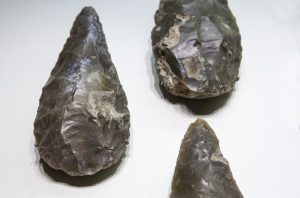Did Neanderthals Start Fires?
It is one of the most iconic Christmas songs of all time.
Written by Bob Wells and Mel Torme in the summer of 1945, “The Christmas Song” (subtitled “Chestnuts Roasting on an Open Fire”) was crafted in less than an hour. As the story goes, Wells and Torme were trying to stay cool during the blistering summer heat by thinking cool thoughts and then jotting them down on paper. And, in the process, “The Christmas Song” was born.
Many of the song’s lyrics evoke images of winter, particularly around Christmastime. But none has come to exemplify the quiet peace of a Christmas evening more than the song’s first line, “Chestnuts roasting on an open fire . . . ”
Gathering around the fire to stay warm, to cook food, and to share in a community has been an integral part of the human experience throughout history—including human prehistory. Most certainly our ability to master fire played a role in our survival as a species and in our ability as human beings to occupy and thrive in some of the world’s coldest, harshest climates.
But fire use is not limited only to modern humans. There is strong evidence that Neanderthals made use of fire. But, did these creatures have control over fire in the same way we do? In other words, did Neanderthals master fire? Or, did they merely make opportunistic use of natural fires? These questions are hotly debated by anthropologists today and they contribute to a broader discussion about the cognitive capacity of Neanderthals. Part of that discussion includes whether these creatures were cognitively inferior to us or whether they were our intellectual equals.
In an attempt to answer these questions, a team of researchers from the Netherlands and France characterized the microwear patterns on bifacial (having opposite sides that have been worked on to form an edge) tools made from flint recovered from Neanderthal sites, and concluded that the wear patterns suggest that these hominins used pyrite to repeatedly strike the flint. This process generates sparks that can be used to start fires.1 To put it another way, the researchers concluded that Neanderthals had mastery over fire because they knew how to start fires.

Figure 1: Biface tools for cutting or scraping. Image credit: Shutterstock
However, a closer examination of the evidence along with results of other studies, including recent insight into the cause of Neanderthal extinction, raises significant doubts about this conclusion.
What Do the Microwear Patterns on Flint Say?
The investigators focused on the microwear patterns of flint bifaces recovered from Neanderthal sites as a marker for fire mastery because of the well-known practice among hunter-gatherers and pastoralists of striking flint with pyrite (an iron disulfide mineral) to generate sparks to start fires. Presumably, the first modern humans also used this technique to start fires.

Figure 2: Starting a fire with pyrite and flint. Image credit: Shutterstock
The research team reasoned that if Neanderthals started fires, they would use a similar tactic. Careful examination of the microwear patterns on the bifaces led the research team to conclude that these tools were repeatedly struck by hard materials, with the strikes all occurring in the same direction along the bifaces’ long axis.
The researchers then tried to experimentally recreate the microwear pattern in a laboratory setting. To do so, they struck biface replicas with a number of different types of materials, including pyrites, and concluded that the patterns produced by the pyrite strikes most closely matched the patterns on the bifaces recovered from Neanderthal sites. On this basis, the researchers claim that they have found evidence that Neanderthals deliberately started fires.
Did Neanderthals Master Fire?
While this conclusion is possible, at best this study provides circumstantial, not direct, evidence for Neanderthal mastery of fire. In fact, other evidence counts against this conclusion. For example, bifaces with the same type of microwear patterns have been found at other Neanderthal sites, locales that show no evidence of fire use. These bifaces would have had a range of usages, including butchery of the remains of dead animals. So, it is possible that these tools were never used to start fires—even at sites with evidence for fire usage.
Another challenge to the conclusion comes from the failure to detect any pyrite on the bifaces recovered from the Neanderthal sites. Flint recovered from modern human sites shows visible evidence of pyrite. And yet the research team failed to detect even trace amounts of pyrite on the Neanderthal bifaces during the course of their microanalysis.
This observation raises further doubt about whether the flint from the Neanderthal sites was used as a fire starter tool. Rather, it points to the possibility that Neanderthals struck the bifaces with materials other than pyrite for reasons not yet understood.
The conclusion that Neanderthals mastered fire also does not square with results from other studies. For example, a careful assessment of archaeological sites in southern France occupied by Neanderthals from about 100,000 to 40,000 years ago indicates that Neanderthals could not create fire. Instead, these hominins made opportunistic use of natural fire when it was available to them.2
These French sites do show clear evidence of Neanderthal fire use, but when researchers correlated the archaeological layers displaying evidence for fire use with the paleoclimate data, they found an unexpected pattern. Neanderthals used fire during warm climate conditions and failed to use fire during cold periods—the opposite of what would be predicted if Neanderthals had mastered fire.
Lightning strikes that would generate natural fires are much more likely to occur during warm periods. Instead of creating fire, Neanderthals most likely harnessed natural fire and cultivated it as long as they could before it extinguished.
Another study also raises questions about the ability of Neanderthals to start fires.3 This research indicates that cold climates triggered Neanderthal extinctions. By studying the chemical composition of stalagmites in two Romanian caves, an international research team concluded that there were two prolonged and extremely cold periods between 44,000 and 40,000 years ago. (The chemical composition of stalagmites varies with temperature.)
The researchers also noted that during these cold periods, the archaeological record for Neanderthals disappears. They interpret this disappearance to reflect a dramatic reduction in Neanderthal population numbers. Researchers speculate that when this population downturn took place during the first cold period, modern humans made their way into Europe. Being better suited for survival in the cold climate, modern human numbers increased. When the cold climate mitigated, Neanderthals were unable to recover their numbers because of the growing populations of modern humans in Europe. Presumably, after the second cold period, Neanderthal numbers dropped to the point that they couldn’t recover, and hence, became extinct.
But why would modern humans be more capable than Neanderthals of surviving under extremely cold conditions? It seems as if it should be the other way around. Neanderthals had a hyper-polar body design that made them ideally suited to withstand cold conditions. Neanderthal bodies were stout and compact, comprised of barrel-shaped torsos and shorter limbs, which helped them retain body heat. Their noses were long and sinus cavities extensive, which helped them warm the cold air they breathed before it reached their lungs. But, despite this advantage, Neanderthals died out and modern humans thrived.
Some anthropologists believe that the survival discrepancy could be due to dietary differences. Some data indicates that modern humans had a more varied diet than Neanderthals. Presumably, these creatures primarily consumed large herbivores—animals that disappeared when the climatic conditions turned cold, thereby threatening Neanderthal survival. On the other hand, modern humans were able to adjust to the cold conditions by shifting their diets.
But could there be a different explanation? Could it be that with their mastery of fire, modern humans were able to survive cold conditions? And did Neanderthals die out because they could not start fires?
Taken in its entirety, the data seems to indicate that Neanderthals lacked mastery of fire but could use it opportunistically. And, in a broader context, the data indicates that Neanderthals were cognitively inferior to humans.
What Difference Does It Make?
One of the most important ideas taught in Scripture is that human beings uniquely bear God’s image. As such, every human being has immeasurable worth and value. And because we bear God’s image, we can enter into a relationship with our Maker.
However, if Neanderthals possessed advanced cognitive ability just like that of modern humans, then it becomes difficult to maintain the view that modern humans are unique and exceptional. If human beings aren’t exceptional, then it becomes a challenge to defend the idea that human beings are made in God’s image.
Yet, claims that Neanderthals are cognitive equals to modern humans fail to withstand scientific scrutiny, time and time, again. Now it’s time to light a fire in my fireplace and enjoy a few contemplative moments thinking about the real meaning of Christmas.
Resources
- Who Was Adam? by Fazale Rana with Hugh Ross (book)
- “Were Neanderthals People, Too? A Response to Jon Mooallem” by Fazale Rana (article)
- “New Research Douses Claim that Neanderthals Mastered Fire” by Fazale Rana (article)
- “One-of-a-Kind: Three Discoveries Affirm Human Uniqueness” by Fazale Rana (article)
- “Neanderthal Brains Make Them Unlikely Social Networkers” by Fazale Rana (article)
- “Differences in Human and Neanderthal Brains Explain Human Exceptionalism” by Fazale Rana (article)
- “Did Neanderthals Have the Brains to Make Art?” by Fazale Rana (article)
Check out more from Reasons to Believe @Reasons.org
Endnotes
- A. C. Sorensen, E. Claud, and M. Soressi, “Neanderthal Fire-Making Technology Inferred from Microwear Analysis,” Scientific Reports 8 (July 19, 2018): 10065, doi:10.1038/s41598-018-28342-9.
- Dennis M. Sandgathe et al., “Timing of the Appearance of Habitual Fire Use,” Proceedings of the National Academy of Sciences, USA 108 (July 19, 2011), E298, doi:10.1073/pnas.1106759108; Paul Goldberg et al., “New Evidence on Neandertal Use of Fire: Examples from Roc de Marsal and Pech de l’Azé IV,” Quaternary International 247 (2012): 325–40, doi:10.1016/j.quaint.2010.11.015; Dennis M. Sandgathe et al., “On the Role of Fire in Neandertal Adaptations in Western Europe: Evidence from Pech de l’Azé IV and Roc de Marsal, France,” PaleoAnthropology (2011): 216–42, doi:10.4207/PA.2011.ART54.
- Michael Staubwasser et al., “Impact of Climate Change on the Transition of Neanderthals to Modern Humans in Europe,” Proceedings of the National Academy of Sciences, USA 115 (September 11, 2018): 9116–21, doi:10.1073/pnas.1808647115.



